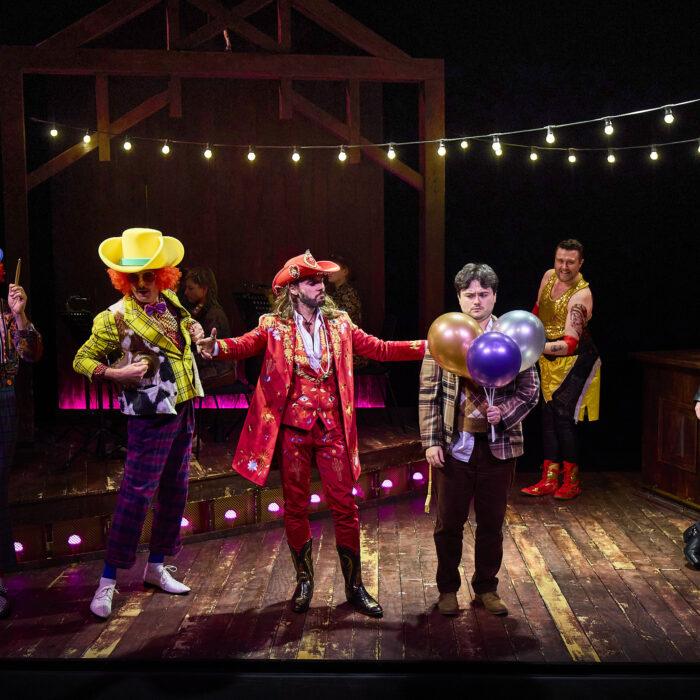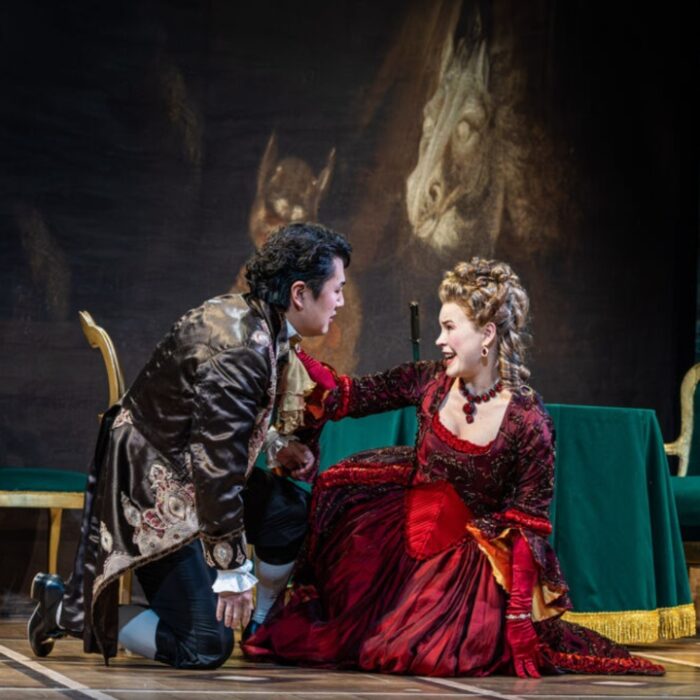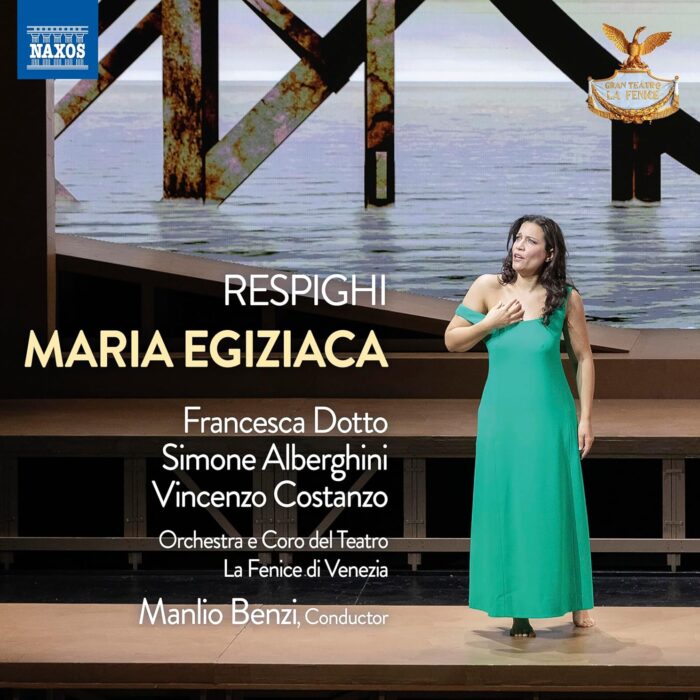
Opera Holland Park/Charles Court Opera 2024 Review: The Yeomen of the Guard
John Savournin’s Deft Production Shows off Some Superb Voices, Despite a Few Wrinkles
By Benjamin Poore(Photo: Ellie Kurttz)
John Savournin returned with Charles Court Opera for their fourth collaboration with Opera Holland Park, following 2023’s zesty “Ruddigore”. In 2024 they have opted for one of the most tonally and musically complex of Gilbert and Sullivan’s Savoy operas in “The Yeomen of the Guard”, whose mood is darker and dramaturgy complex, treading an awkward line between witty silliness and something more grandly Verdian, with Gilbert’s cod-Shakesperian prose between the numbers. There is no taking the easy way out with “The Mikado” or “Gondoliers” for Savournin and company, whose productions mostly have a traditional bent with a few knowing winks, but always treating the material with utmost seriousness. David Eaton, CCO Music Director, conducted the City of London Sinfonia.
The story of “Yeomen” sees the unjustly imprisoned Colonel Fairfax awaiting execution in the Tower of London on a trumped-up charge of witchcraft. He has caught the eye of Sergeant Meryll’s daughter Phoebe, who, with him, hatches a plot to release Fairfax involving the Meryll’s son; complications arise when he is married off at last-minute to a (blindfolded) Elsie for his fortune, one half of a traveling comic duo with the laconic comedian Jack Point.
The jealous “assistant tormentor” Wilfred Shadbolt, fond in turn of Phoebe, tries to unravel the plot with Point for their own bitter reasons, but they fail; reluctant marriages, all designed to keep secrets and save face, ensue, and Point meets a particularly unhappy end, testing the emotional bandwidth available to operetta in a fascinating way. It contains Sullivan’s most ambitious, harmonically inventive music – the orchestra he engaged for it would barely fit in the pit at the Savoy theater – calling for virtuosity and expressive intensity.
Holland House’s own facade, upstage of the action, was built in 1605. It shares the period of the opera’s setting and suggests a grand Jacobean country house. Alyson Cummins’ set sticks to the period; the backdrop is a map of 17th-century east London around the tower, with the gaol in front, with the front apron used as a playing area for the dialogue scenes. Jake Wiltshire’s lighting aids the work’s gloomy tone and is accentuated by the dusk that falls over the park after the interval. Costumes, likewise, are traditional – Beefeaters and Elizabethan shirts and hose.
Savournin, though, offers a little additional directorial framing – a mutton-chopped man in Victorian dress suggesting Gilbert himself is seen at the opening bringing the characters to life, and appears in the background as a figurant later in the show. Either side of the castle we see properties boxes, stage left and right signs, and the other trappings of backstage. Both the Gilbert-cipher and these features suggest some intriguing meta-theatrical investigation of the work, but their purpose never quite became clear, beyond an homage to G&S’ theatrical creativity, and had little bearing on the story. I was rather hoping Gilbert might step in and do something drastic, or that the framing might come to life, but both remained mute.
Savournin is a fine director though and in his hands a traditional execution of the story is compelling. (By contrast ENO’s 2022 production updated it to the 1950s and interpolated material from other operettas, as well as tweaking the dialogue). Jack Point – the work’s pivotal figure – is played with blistering intensity by Matthew Kellett (a beloved CCO regular), literally acrobatic and full of physical and verbal energy that seems powered by spite, bitterness, and insecurity – even if some of the humor in the first takes quite a while to warm up. One stumbling block came from the use of amplification in the dialogue – a wise move in the acoustically variable space, but unevenly deployed and alarmingly intermittent; one imagines these technical foibles worked themselves out over the course of the show’s four-night run.
At the end, Savournin takes a bold run at one of the work’s contested stage conventions, in which Point collapses insensible after his final rejection from Elsie; in Savournin’s show he swigs a vial of poison and dies right there. It is stark and challenging and shows the emotional seriousness that Savournin sees in the material and really packs a punch. His own role as Shadbolt is equally well drawn, pathetic and ghoulish without ever being cartoonish. William Morgan’s Fairfax has an offhand lightness to the topsy-turvy paradoxes and mischief Gilbert affords him, and was in supple, creamy voice.
Charles Court Opera matched their dramatic seriousness about these pieces with vocal rigor, and the voices impressed. Kellett’s great advantage – aside from being able to caper like an acrobat and act well – is unlike many of the comic baritones recruited to these roles in G&S he can sing with technical assurance and enormous presence. It is critical given the emotional and dramatic burden shouldered by his lament ‘I have a song to sing, O’, which he delivered with luminous pathos at the very end; elsewhere his diction was stout and brilliant, with the voice unfaltering and engaging. Savournin’s own treacly voice was another treat, giving inky depth to his character. Bass-baritone Stephen Gadd gave Sir Richard Cholmondeley an heroic ring that felt highly attuned to the grand opera qualities of the piece.
Llio Evans walked Elsie Maynard while a last-minute Ellie Laugharne sang and spoke the role from the pit. The feat of daring certainly paid off, and each is a credit to the other. Laugharne was the finest voice of the evening, crystalline, gleaming, and taking full lyrical flight; Evans played along with gusto. Samantha Price’s Phoebe Meryll was another vocal high point, richer and more tender than Laugharne, and a more wounded vocal presence. Amy J Payne as Dame Carruthers convinced less, with uneven changes of registration that made for an unsettled introductory aria, though as with all her colleagues acted with unstinting commitment.
Playing from the City of London Sinfonia was a little rockier than usual, especially in an unsettled overture whose devilish string passagework didn’t quite gleam, with unsteady moments of ensemble and some wayward tuning. They weren’t helped by the fact that the reduced orchestration (Richard Balcombe) really does work to the detriment of Sullivan’s score, whose Wagnerian opening is redolent of “Die Meistersinger” and calls for breadth, depth, richness, and gleam, only really possible from fuller brass and string forces, and they struggled to set the work’s imposing mood.
The Act one finale, however – as dark as anything Verdi wrote in “Don Carlo” – had plenty of imposing power and presence, once the music had settled. Eaton’s own conducting is crisp and nimble, ramping up the musical tension as the work’s final scenes unfolded and marshaling choral and instrumental forces admirably. The OHP Chorus again proved themselves redoubtable, with marvelous diction and equally nimble dancing – always an impressive part of their summer offering, and surely the envy of more flat-footed choristers on English opera stages. The show is less consistent than some of Charles Court Opera’s previous appearances in west London, but creatively they still run a very tight ship.


